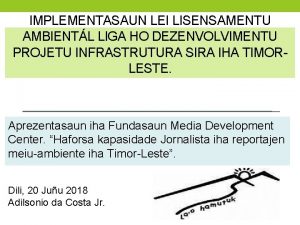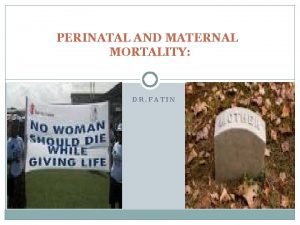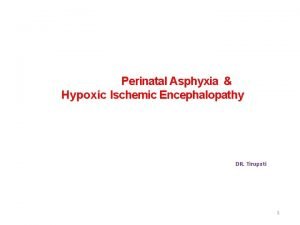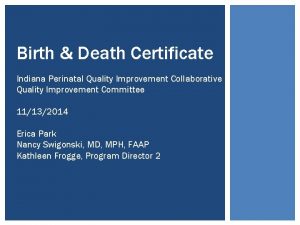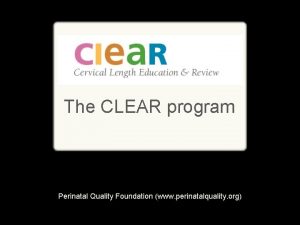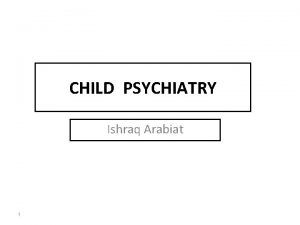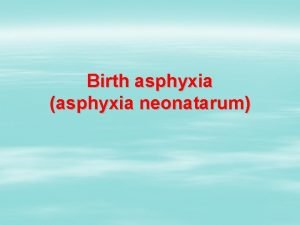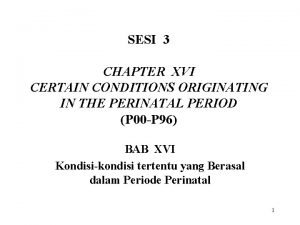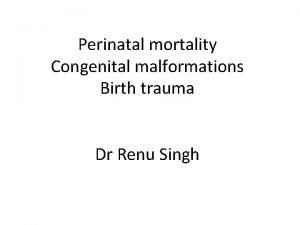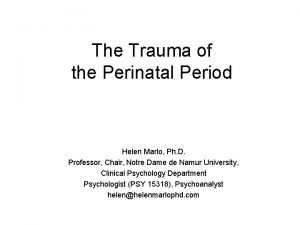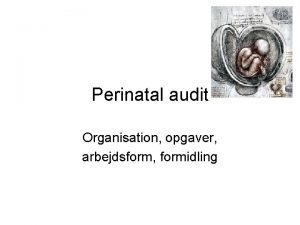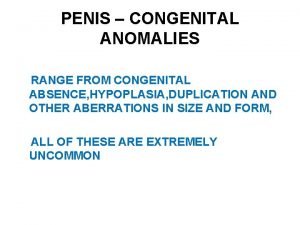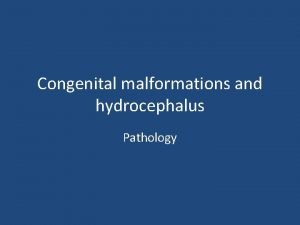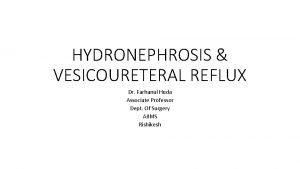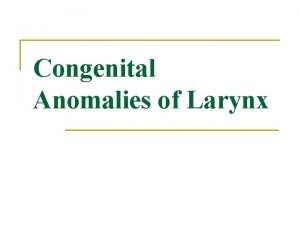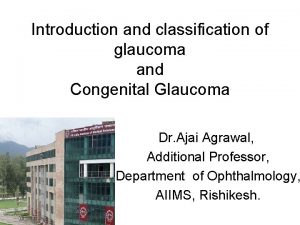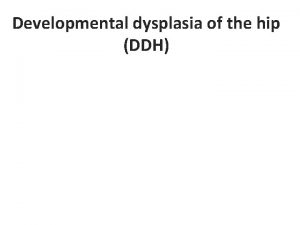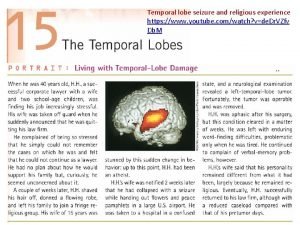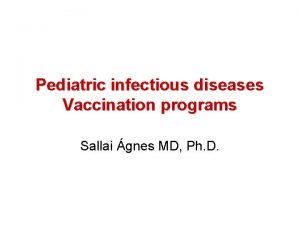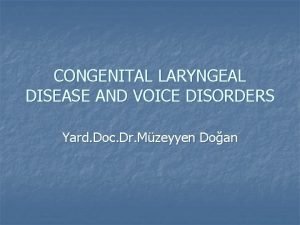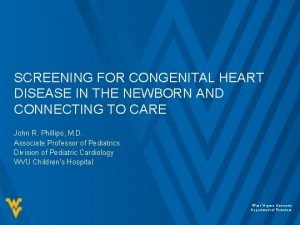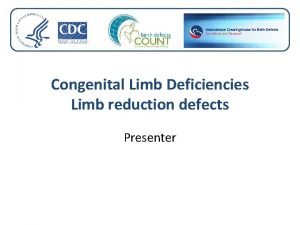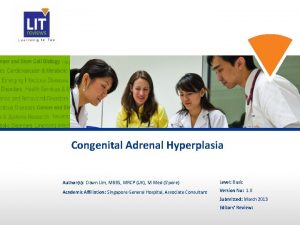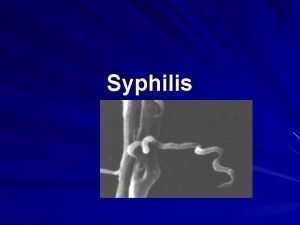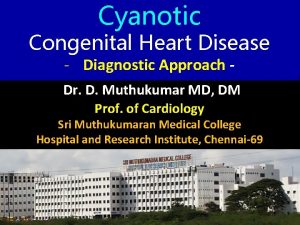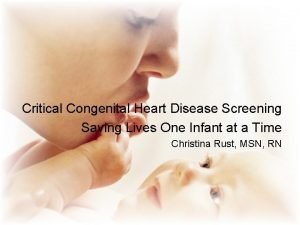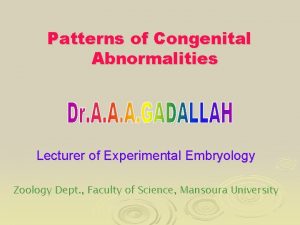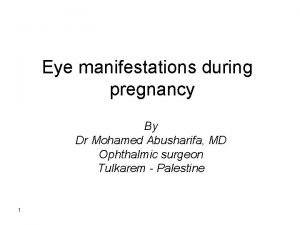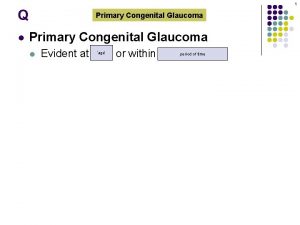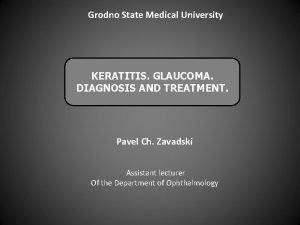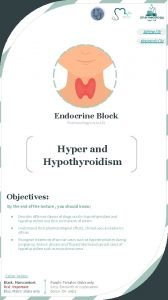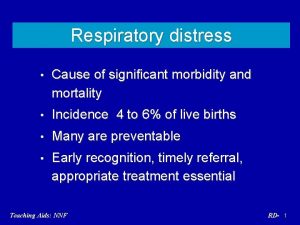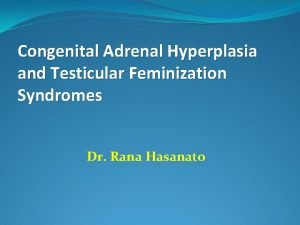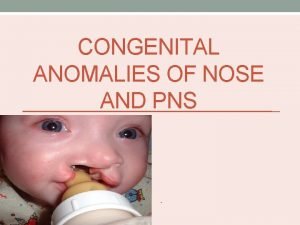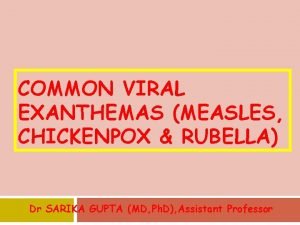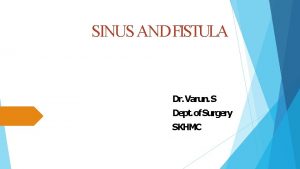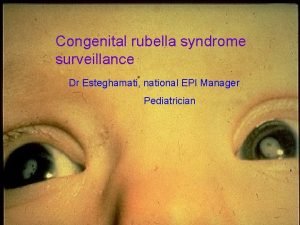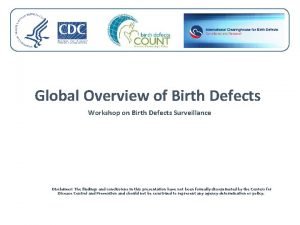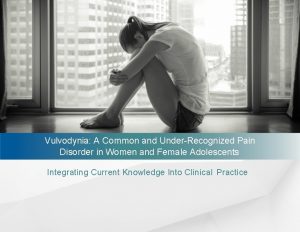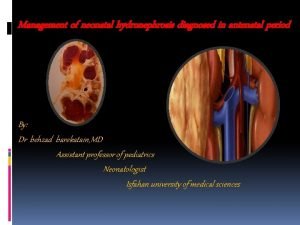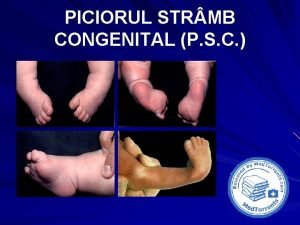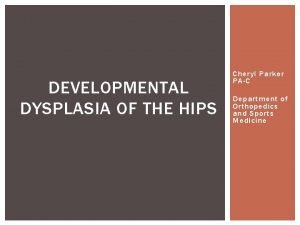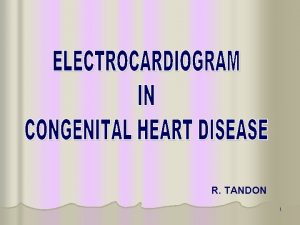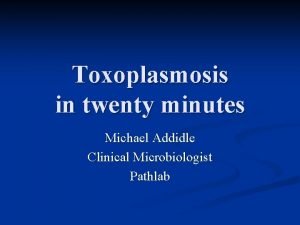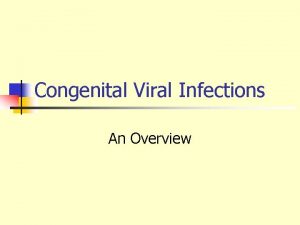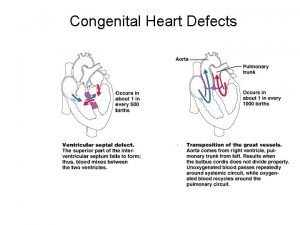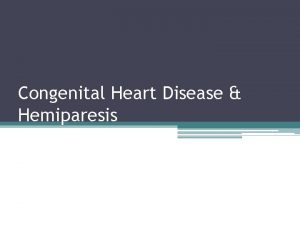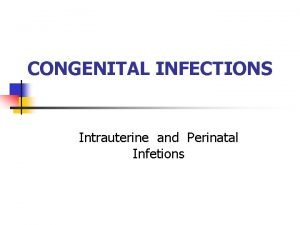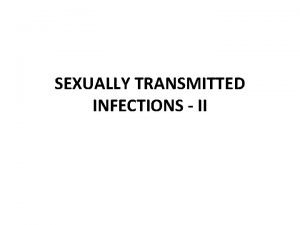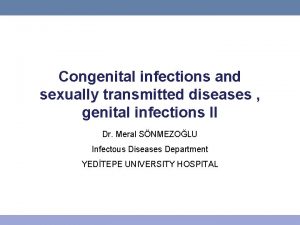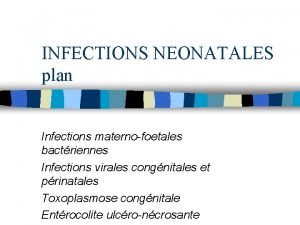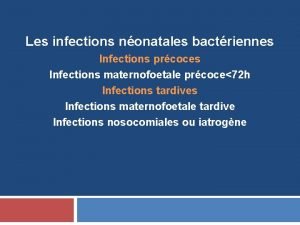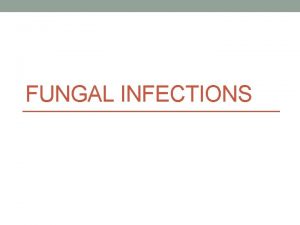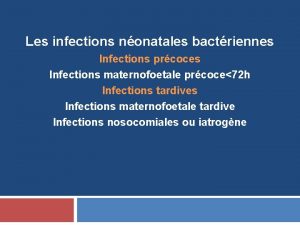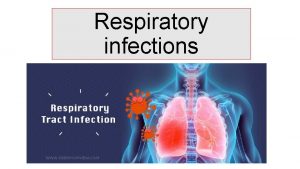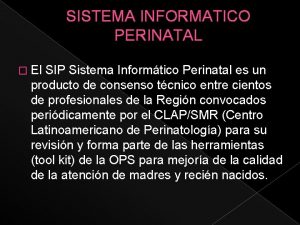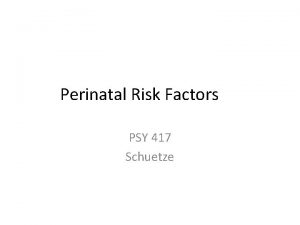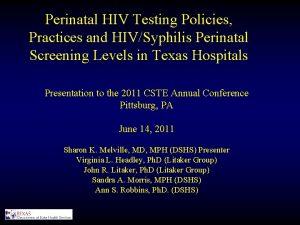CONGENITAL Perinatal INFECTIONS Dr Hira Rauf Sargodha medical































































































- Slides: 95

CONGENITAL/ Perinatal INFECTIONS Dr. Hira Rauf Sargodha medical college Lecture: Final year MBBS

CONGENITAL INFECTIONS n Certain groups of congenital infection of the newborn n n are known by the name: TORCH by the acronym: Toxoplasmosis. Others (syphilis, HIV, coxsackie virus, hepatitis B, varicella-zoster). Rubella. Cytomegalovirus disease & Herpes simplex disease. The overall incidence of these infections is about 2, 5% at live newborns. The diagnosis from birth of these infections is very important because long term prognosis is affected.

CONGENITAL INFECTIONS n Intrauterine infections can generate: - Abortion; - Stillbirth child; - Prematurity; - IUGR; - Congenital malformations; Transmission: n Transplacental - the most frequent. n Infected amniotic fluid; n During delivery;

CONGENITAL INFECTIONS n The severity or the clinical manifestation of these infections at fetus or newborn depends on: 1. Gestational age - abortions and stillbirth child appear at early time of gestation. 2. The virulence of pathogen agent; 3. Primary or recurrent infections of the mother; 4. If fetus or newborn received transfer of antibodies from the mother;

CONGENITAL INFECTIONS The mechanism by TORCH infections can produce congenital malformation may be explain by: n The pertubance of embriogenesis; n Tissular destruction of already formed organs; Clinical manifestations of these infections may be: n Absent; n Subtle; n Non-specific; n Common with others diseases: RDS, sepsis.

CONGENITAL INFECTIONS n These congenital are grouped together because of similar clinical presentation in many patients: 1. 2. 3. 4. 5. 6. 7. Premature delivery; IUGR or intrauterine death; Jaundice, petechia or purpura; Hepatosplenomegaly, anemia, trombocytopenia; Hydrocephaly, microcephaly, intracranial calcification; Chorioretinitis, Myocarditis & cardiac abnormalities.

CONGENITAL INFECTIONS. Diagnosis approach. Common signs Non-specific laboratory tests 1. IUGR 6. Hidrocephaly CBC Count CSF exam. Skull film CT- scan Ophthalmologic exam ORL exam 7. Intracranial calcification 10. Chorioretinitis 8. Miocarditis 11. Keratoconjuctivitis 2. Hepatosplenomegaly 3. Jaundice 4. Petechiae, echimosis 5. Microcephaly 9. Congenital heart disease 12. Glaucom

CONGENITAL INFECTIONS n Mental retardation, deafness, visual sequel can be diagnosticated later, hence the importance of correct diagnosis and management of a newborn under suspicion with TORCH infecion. For each disease of this group there are specific signs and laboratory tests.

CONGENITAL INFECTIONS Specific clinical signs Specific laboratory tests TOXOPLASMOSIS Serologic tests: ■ Ig. M, Ig. G, Ig. A ■ Ag HBs, Ag HBc, Ag. HBe - ELISA Viral cultures: ■Nasal pharynx & throat ■Conjunctiva ■Feces ■Cultures from characteristic lesions. ■Urine ■Bloodfor. HIV ■CSF Hidrocephaly Intracerebral calcifications Chorioretinitis RUBELLA Cataracts or glaucoma Hearing loss Congenital heart disease CYTOMEGALOVIRUS Microcephaly with periventric. calcification Petechiae HERPES SIMPLEX Skin lesions Keratoconjuctivitis CNS involvement

CONGENITAL INFECTIONS - TOXOPLASMOSIS Toxoplasma gondii is a protozoan parasite capable of causing intrauterine infection. Incidence-varies from 12, 5 -1, 5%? , as primary infection for pregnant women and approximately 0, 56, 5%; as congenital infection. The transmission of toxoplasmosis in human being, may be: n Digestive-ingestion of unpasteurized milk, undercooked meat; n Contact with cats feces; n Hematogenous route-transplacental; n Via blood products transfusion.

CONGENITAL INFECTIONS - TOXOPLASMOSIS n Infections transmitted earlier in gestation are likely to cause more severe fetal effects (abortion, stillbirth, or severe disease with teratogenesis). Those transmitted later are more apt to be subclinical. Rarely, a parasite may be transmitted via an infected placenta during parturition. Infections in the fetus or neonate usually involve disease in one or two forms: infection of the CNS or eyes, or infection of the CNS and eyes with disseminated infection. 70 -90% of infants with congenital infection is asymptomatic at birth. However, visual impairment, learning disabilities, or mental impairment becomes apparent in a large percentage of children months to several years later.

CONGENITAL INFECTIONS - TOXOPLASMOSIS If the mother is infected, the infection may or not be transmitted to the fetus. The later in pregnancy that infection is aquired, the more likely is transmission to the fetus: n 14% in first trimester; n 29% in second trimester; n 59% in third trimester;

TOXOPLASMOSIS - Clinical presentation Congenital toxoplasmosis may be manifested as clinical neonatal disease, disease in the first few months of life, late sequel or subclinical disease. n Clinical disease those who present with evident clinical disease may have disseminated illness or isolated CNS or ocular disease. Late sequel is primarily related to ocular or CNS disease. n Obstructive hydrocephalus¹, chorioretinitis² and intracranial calcifications³ form the classic triad of toxoplasmosis.

TOXOPLASMOSIS - Clinical presentation Signs and symptoms in infants with congenital toxoplasmosis include: n chorioretinitis n abnormalities of CNS(high protein value); n anemia; n seizures; n intracranial calcification; n direct hyperbilirubinemia; n fever; n hepatosplenomegaly; n lymphadenophaty, n vomiting; n microcephaly or hidrocephaly; n cataracts/glaucoma/optic atrophy; n eosinophilia/bleeding diathesis; n rash; n pneumonitis.

TOXOPLASMOSIS - Clinical presentation n Toxoplasmosis has been associated with congenital nephrosis, myocarditis and isolated mental retardation. n Subclinical infection is believed to be the most common. Studies of this infant (in whom infection is identified by serologic testing or documented maternal infection) indicate that a large percentage may have minor CSF abnormalities at birth and later develop visual or neurological sequel or learning disabilities.

TOXOPLASMOSIS - Diagnosis Prenatal diagnosis - can be made by detecting the parasite in fetal blood or amniotic fluid, or by documenting toxo Ig. M and Ig. A antibodies in fetal blood. Direct isolation of the organism from body fluids or tissues - requires inoculating bloods, body fluids, or placental tissue into mice or tissue culture and is not already available. Serologic tests - toxoplasma specific Ig. M antibodies can be measured by indirect fluorescent antibody (IFA) test, enzyme-linked immunosorbent assay (ELISA), or Ig. M immunosorbent agglutination assay (Ig. M-ISAGA); usually become positive within 1 -2 weeks of infection. If Ig. M titters are high and accompanied by high specific Ig. G titters, as measured by IFA or Sabin. Feldman dye test, this suggests acute infection. Ig. A antibodies are found in more than 95% of patient with acute infections. Toxoplasma -specific Ig-E antibodies are found in almost all women who seroconvert during pregnancy. CSF - examination should be performed in suspected cases. The most characteristic abnormalities are xantochromia, mononuclear pleocytosis and a very high protein level. Skull film or CT scan of the head may demonstrate characteristic intracranial calcifications. Ophtalmologic exam characteristically shows chorioretinitis.

TOXOPLASMOSIS – management & treatment Management. Prevention pregnant women should avoid eating raw meat or raw eggs and avoid exposure to cat feces. Treatment of symptomatic infants during the first 6 -month of life consist of a combination of: n Pyrimethamine -1 mg/kg orally in 1 or 2 divided doses daily after an iniţial loading dose of 2 -mg/kg day for two days. n Sulfadiazine-100 mg/kg/day orally, in two divided doses. n Leucovorin (folinic acid) is given 5 -10 mg every 3 days. After a 6 month regimen, treatment can be continued or modified to include 1 -month courses or spiramycin alternating with 1 -month courses of pyrimethamine, sulfadiazine and leucovorin for an additional 6 month. Spiramycine is a macrolide antibiotic; it is given daily at a dose of 100 mg/kg/day in two divided oral doses. n Corticosteroids are somewhat controversial; prednisone is given 1, 5 mg/kg/day orally in two divided doses, in infants with chorioretinitis or elevations in spinal fluid protein, in order to decrease the inflammatory response.

TOXOPLASMOSIS – management & treatment n Infants with symptomatic congenital toxoplasmosis are also n n treated for one year. They receive an iniţial 6 weeks course of pyrimethamine, sulfadiazine and leucovorin followed by alternating courses of spyramicine for 6 weeks and the other three drugs repeated for 4 weeks. Healthy infants bom to mothers with gestational toxoplasmois can be treated with a 4 weeks course of pyrimethamine, sulfadiazine and leucovorin. If diagnosis of congenital toxoplasmosis is established later, chemotherapy is continued as delineated for infants with subclinical infections. Infants treated with pyrimethamine and sulfadiazine require weekly blood counts, platelet counts and urine microscopy to detect any adverse drug effects.

RUBELLA n Definition = viral infection capable of causing chronic n n n n intrauterine infection and damage to the developing fetus. Incidence - varies from 0. 1% to 2% of birth with higher incidence after rubella epidemics. The fetal infection rate varies according to the timing of maternal infection during pregnancy: 1 - 12 weeks, there is an 81% risk of fetal infection; 17 - 22 w. = 36% risk; 23 - 30 w. = 30% risk; 31 - 36 w. = 60% risk; Last month of pregnacy = 100%. However, the incidence of fetal effects is greater. Earlier in gestation that infection occur, (especially at 1 -8 weeks) 85% of fetus will be damaged. Placental or fetal infection may lead to resorbtion of the fetus, spontaneous abortion, stillbirth, and fetal infection from multisystemic disease, congenital malformation, or inapparent infection.

RUBELLA n Pathophysiology Rubella virus is an RNA virus. Human are the only known hosts, with an incubation period of ~18 days following contact. Virus is spread by respiratory secretions, and is also spread from stool, urine and cervical secretions. Maternal viremia is a prerequisite for placental infection, which may or may not spread to the fetus (there is a high incidence of subclinical infections). Most cases occur following primary disease. Maternal antibodies to previous infection are protective for the fetus. n The disease involves angiopathy as well as cytolytic changes. Other viral effects include chromosome breakage, decreased cell multiplication time, and mitotic arrest in certain cell types. There is a little inflammatory reaction. n Risk factors - women of childbearing age who are rubella nonimmune.

RUBELLA Clinical presentation Rubella has a wide spectrum of presentations, ranging from acute disseminated infection to deficit and defects not evident at birth. Clinical manifestation can be categorized in three groups: 1. Transitory phenomena: -Trombocytopenia - Hepatitis; 2. Permanent structural defects: - Congenital heart malformation; - Cataracts; 3. Later presenting defects: - Sensorineural hearing loss; - Diabetes mellitus;

RUBELLA Congenital rubella syndrome presents a classic triad: 1. 2. 3. Cataracts (in 1/3 of cascs); Sensorineural hearing loss is the most frequent sequelae 80% of infected children; Congenital malformation in ~ 50% of children infected in first 8 w. of gestation and consist in PDA, pulmonary artery stenosis);

RUBELLA n 1. 2. 3. 4. 5. 6. Clinical signs at birth: IUGR; Splenomegaly; Trombocytopenia; Signs of meningoencephalitis; Signs of interstitial pneumonia; Adenophaty. n 1. 2. 3. 4. Other signs, less common: Prematurity; Hepatitis; Anemia; Purpura, rash, petechiae.

RUBELLA n 1. 2. 3. 4. 5. 6. 7. Later presentation defects: Diabetes mellitus & thyroid disease; Hearing deficit; Glaucoma; Arterial hypertension; Progressive mental retardation; Autism; Subacute sclerosing panencephalitis, due to meningoencephalitis

RUBELLA Diagnosis n Open cultures-the virus can be cultured from: Nasopharyngeal swabs, conjuctival scrapings; urine; CSF. n CSF examination -may reveal encephalitis with an increased protein cellular ratio in some cases. n Serologic studies - may be helpful, but the disease itself may cause immunology aberration and delay the infant's ability to mount Ig. M or Ig. G responses. n Radiological studies - may show metaphyseal radiolucencies that correlate with metaphyseal osteoporosis. n Unspecific test -hematological exploration, bilirubin determination, ECHO exams. Treatment n Prophylaxis anti-rubella vaccine of the susceptible population, especially young children. Vaccine should not be given to pregnant women. Passive immunization does not prevent fetal infection when maternal infection occurs. n There is no specific treatment for rubella. Long term follow-up is needed secondary to late-onset symptoms.

CYTOMEGALOVIRUS (CMV) Definition: - CMV is a DNA virus and a member of the “herpesvirus group”. Incidence: - CMV is the most frequent cause for IUGR, with a 1 -2% incidence in newborn population. Pathophysiology CMV is a ubiquitous virus that may be transmitted in secretions, blood, and urine and perhaps by sexual contact. More than 90% of primary CMV infections are asymptomatic. CMV is capable of penetrating the placental barrier as vvell as the blood brain barrier. Both primary and recurrent maternal CMV can lead to transmission of virus to the fetus.

CYTOMEGALOVIRUS n The period for the greatest fetal risk for disease and subsequent n n neurologic impairment is the first 22 weeks of gestation. Fetal viremia is spread by hematogenous route. The primary target organs are CNS, eyes, liver, lungs and kidneys. Characteristic histopathological features of CMV include focal necrosis, inflammatory response, the formation of enlarged cells with intranuclear inclusions (cytomegalic cells), and the production of multinucleated gigantic cells. CMV may also be transmitted to the infant at delivery (with cervical colonization), via breast milk, and via transfusion of seropositive blood to an infant whose mother is seronegative. Risk factors: n Lower social -economic status; n Drug abuse; n Sexual promiscuity in the mother

CYTOMEGALOVIRUS Clinical presentation - Subclinical infection is 10 times more frequent than clinical illness. The most frequent signs: 1. 2. 3. 4. Hepatosplenomegaly; Thrombocytopenia with or without purpura; Petechiae; Jaundice with high direct bilirubin level; Rare signs: n n n Inguinal hernia at male; Chorioretinitis; Optic atrophy; Sign of severity: n n Microcephaly; Intracerebral calcifications; IUGR; Prematurity.

CYTOMEGALOVIRUS By 2 years of age 5 -15% of infants who are asymptomatic at birth, may develop serious sequel such as hearing loss and ocular abnormalities. Late sequel with subclinical infection, such as: Ø Mental retardation; Ø Learning disabilities; Ø Sensorineural hearing loss Have been attributed to CMV. Studies have now shown for children with asymptomatic congenital CMV infection a prevalence of sensorial hearing loss of 7, 2%. Approximately one half had bilateral loss, and 50% of affected children had progressive deteriration. Repeated auditory evaluation during the first 3 years is strongly recommended.

CYTOMEGALOVIRUS Diagnosis n The standard diagnostic for CMV infection is urine or saliva culture. Most urine specimens from infants with congenital CMV are positive within 48 -72 h. n Serologic tests - are available, but not specific complement fixation test that measures Ig. G will detect more than 75% of positive cases but also has a significant false-positive rate. n Radiological studies - skull films or CT scans of the head may demonstrate characteristic intracranian calcifications. Management n Prevention - standard precautions, especially good hand washing. n Control of blood products; n Antiviral agents - ganciclovir has been show to be partially effective in the treatment of newborn with symptomatic infection, but this drug is mutagenic, teratogenic and carcinogenic.

n Questions? ? ?

HERPES SIMPLEX VIRUS Definition: n Herpes simplex virus (HSV) is a DNA virus related to CMV, Epstein-Barr virus, and varicella virus, and is among the most prevalent of all viral infections encountered by humans. Incidence: n The estimated rate of occurrence of neonatal HVS is 1/1000 to 1/5000 deliveries per year. Pathophysiology: n There are two serologic subtypes of HSV: HSV-1 (orolabial) and HSV-2 (genital). Three quarters of neonatal herpes infections are secondary to HSV-2, with the remainder caused by HSV-1. n HSV infection of the neonate can be acquired intrauterine, intrapartum, or postnatal. Most infections are acquired in intrapartum period as ascending infections with rupture membranes or by delivery through an infected cervix or vagina.

HERPES SIMPLEX VIRUS Clinical aspects: Intrauterine infection is different from acquired infection. Intrauterine infection: n Skin lesions; n Chorioretinitis; n Micro/hidrocephaly; These cases may have a fatal evolution. The survivors may present neurological sequel, growth retard, ocular and hearing deficits. Perinatal infection: 1. 2. 3. n n n n Localized infections -involving the skin, eyes or oral cavity(42% of cases) CNS localization (35% of cases). Disseminated disease(23% of cases)- which mimic very well bacterial sepsis: Irritability; Termic instability; Apnea spells; Jaundice; Shock; Hepatomegaly; Seizures.

HERPES SIMPLEX VIRUS Clinical manifestation of infection with HSV appear in about: - 16, 2+9 days for CNS involvement; - 11+0, 5 days for localized infection; Neurologic signs may appear in any type of localization and consist in: n Microcephaly; n Spastic tetraplegy; n Treatment resistant seizures; n Blindness; n Growth retardation.

HERPES SIMPLEX VIRUS Diagnosis: n Viral cultures - cultures obtained from conjunctiva, throat, feces, urine, nasal pharynx, and CSF. The virus grows readily, with preliminary results available in 24 -72 h. n Immunologic assays - to detect HSV antigen in lesion scrapings, usually using monoclonal anti-HSV antibodies in either an ELISA or fluorescent microscopy assay, are very specific and 80 -90% sensitive, n Tzanck smear – cytological examination of the base of skin vesicles, looking for characteristic but nonspecific giant cells is only about 50% sensitive. n Serologic tests - are not helpful in diagnosis of neonatal infection. n Lumbar punction - should be performed in all suspected cases. Evidence of hemorrhagic CSF with increased white blood cells and protein may be found.

HERPES SIMPLEX VIRUS n Management Antepartum - correct and prompt diagnosis of herpes genital infection; in case of clinically apparent HSV infection C-section. Neonatal treatment: n Isolation of infants with known infection and careful hand-washing; n The infant may not be breast-feeded as long as breast lesion are present on the mother, and the mother should be instructed in good hand-washing technique. n Pharmacological therapy-the first- line drug of choice is acyclovir, the second choice being vidarabine.

Chicken Pox : n Infective organism : n Chickenpox is caused by the varicella zoster virus n (VZV), a herpes virus that is transmitted by droplet n spread and direct personal contact.

Chicken pox : n Prevalence: n In the UK, over 90% of individuals over 15 years of age are immune to chickenpox. n infection during pregnancy is uncommon, with an estimated prevalence of 3/1, 000 pregnancies.

Chickenpox: CF; n Non-immune pregnant women are more vulnerable to chickenpox and may develop a serious pneumonia, hepatitis or encephalitis. n The mortality rate is approximately five times higher in pregnant women than in nonpregnant adults. n Pneumonia occurs in about 10% of women with chickenpox and seems more severe at later gestations. n It may also cause the fetal varicella syndrome (FVS) or varicella infection of the newborn.

Management: n Women should be asked whether they have had chickenpox at booking n should be advised to avoid contact with it during pregnancy If not n Significant contact is defined as being in the same room as someone for 15 minutes or more, or face-to-face contact. n Individuals with the virus are infectious for 48 hours prior to the appearance of the rash and until the vesicles crust

Management: n contact wth chickenpox, she should have a blood test for confirm. Ation of VZV immunity, by testing for VZV Ig. G. n virology laboratory may be able to use serum from the early pregnancy booking blood sample. n If previously nonexposed give varicella zoster immunoglobulin (VZIG) as soon as possible. VZIG is effective when given up to 10 days Of contact.

Management: n Women with chickenpox should avoid contact n with other pregnant women and neonat until lesionss have crusted over. n Current recommendations state that oral aciclovir 800 mg five times per day n for 7 days should be prescribed for pregnant wome withh chickenpox if they present within 24 hours of the onset of the rash and if they are more than 20 weeks’ gestation. n VZIG has no thera-peutic benefit once chickenpox has developed.

Management: n Admission : : : n If the woman smokes cigarettes, has chronic lung disease, is taking corticosteroids or is in the latter half of pregnancy, a hospital assessment should be considered, even in the absence of complications. n Women hospitalized with varicella should b nursed in isolation.

Management: n The maternal risks are bleed- ing, thrombocytopaenia, disseminate intravascularar coagulopathy and hepatitis. n There s high risk of varicella infection of the newborn with significant morbidity and mortality. n Supportive treatment and intravenous aciclovir is therefore desirable. n However, delivery may be required in women if varicella pneumonia is complicated by respiratory failure.

Fetal risk: n Spontaneous miscarriage not increased n FVS is characterized by one or more of the following: n • Skin scarring in a dermatomal distribution. n • Eye defects (microphthalmia, chorioretinitis cataractss). n • Hypoplasia of the limbs. n • Neurological abnormalities (microcephaly, cortical atrophy, mental restriction and dysfunction of bowel and bladder sphincters). n This only occurs in a minority of infected

Delivery: n Elective delivery should normally be avoided until 5– 7 days after the onset of maternal rash to allow for the passive transfer of antibodies from mother to the infant n If deliver before 7 days VZIG and acyclovir is given to neonate n Arrange eye examination of neonate

Group B streptococcus: Infective organism: Group B streptococcus (Streptococcus agalactiae)(GBS) is a gram-positive coccus frequently found as A vaginal commensal. It can cause sepsis in the neonate and transmission can occur from the time the membranes rupture till delivery.

Group B streptococcus: Prevalence: GBS is recognized as the most frequent cause of severe early-onset (less than 7 days of age) infection in newborn infants. n Approximately 21% of women in UK carry GBS as a commensal in the vagina.

Screening: n Universall screening is carried out in the USA but this practice is not currently recommended in the UK. n Clinical features: n The mother will not have symptoms as GBS is a common vaginal commensal. n An infected neonate may demonstrate signs of neonatal sepsis including sudden collapse, tachypnoea, nasal flaring, poor tone, jaundice, etc.

Management: n Antenatal n If GBS is detected incidentally, antenatal treatment is not recommended as it does not reduce the likelihood of GBS colonization at the time of delivery. n Intrapartum antibiotic prophylaxis n It is during labour that infection of the fetus/neonate occurs. Antibiotics (penicillin or clindamycin) given in labour 60 to 80% reduce chances of Eos d/t GBS in neonate.

Risk factors requiring prophylaxis for GBS n Intrapartum fever (>38°C). n Prolonged rupture of membranes greater than 18 hours. n Prematurity less than 37 weeks. n Previous infant with GBS. n Incidental detection of GBS in current pregnancy. n GBS bacteruria.

Management: n IV penicillin 3 g be given as soon as possible after the onset of labour (or after development of a risk factor) and 1. 5 g four hourly until delivery. Clindamycin 900 mg should be given IV 8 -hourly If penicillinallergic n If chorioamnionitis is suspected, broadspectrum antibiotic therapy including an agent active against GBS should replace GBSspecific antibiotic prophylaxis. n planned caesarean delivery in the absence of labour or mem-brane rupture do not require antibiotic prophylaxis for GBS

Neonate: n If signs of sepsis or disease appear give antibiotics covering Early onset GBS disease. n Csf examination considered n In Hospital care if required

VIRAL HEPATITIS A. n Definition - Hepatitis A is caused by RNA virus transmitted by fecaloral route. n Pathophysiology - the risk of intrauterine transmission is limited because the period of viremia is short and fecal contamination does not occur at the time of delivery. n Clinical presentation - most infants are asymptomatic, with mild anomalies of liver function. n Diagnosis - Ig. M antibodies to hepatitis A virus is present during the acute or early convalescent phase of disease. n Characteristically, the transaminases and serum bilirubin levels are elevated. n Management-the infant should be isolated with enteric precaution. n Immuneglobulin 0, 02 ml/kg, i. m. should be given to the newborn whose mother's symptoms began between 2 weeks before and one week after delivery.

VIRAL HEPATITIS B. Definition - hepatitis B is caused by a DNA virus. It has a long incubation period (45 -160 days) after exposure. Pathophysiology: n If the mother is a chronic carrier, there is a 3 -50% vertical transmission to the infant. In the fetus and the neonate, transmission has been suggested by the following mechanism: n Transplacental transmission either during pregnancy or at the time of delivery secondary to placental leaks. n Natal transmission by exposure to hepatitis B surface antigen in amniotic fluid, vaginal secretions, or maternal blood. n Postnatal transmission, by fecal-oral spread, blood transfusion.

VIRAL HEPATITIS B. Clinical presentation n Maternal hepatitis B infection has not been associated with abortion, stillbirth, or congenital malformations. Prematurity has occurred, especially with acute hepatitis during pregnancy. Fetuses or newborns exposed to HVB present a wide spectrum of disease: n Mild transient acute infection; n Chronic active hepatitis with or without cirrhosis; n Chronic persistent hepatitis; n Chronic asymptomatic Hbs. Ag carriage; n Fulminant fatal hepatitis(rare)

VIRAL HEPATITIS B. Diagnosis n Differential diagnosis - acute biliary atresia and acute hepatitis secondary to other viruses (CMV, rubella). n Transaminases - levels may be markedly increased before the rise in bilirubin levels. n Bilirubin direct and indirect may be elevated. n Test for: Hbs. Ag and anti. HBc-Ig M. Most infant demonstrate antigenemia by 6 month of age, with peak at 3 -4 month.

VIRAL HEPATITIS B. n Management: n Immunization program. WHO has recommended that all countries add HVB vaccine to their routine childhood immunization program by 1997. n Isolation-precaution in handling blood and secretion; n Hbs. Ag-positive mother-the infant should be given hepatitis B immune globulin 0, 5 ml, within 12 h after delivery. If Hbs. Ag status of mother is unknown, test the mother as soon as possible.

CONGENITAL INFECTIONS

SYPHILIS Definition: n Syphilis is a sexually transmitted disease caused by Treponema pallidum. Early congenital syphilis is when clinical manifestation occurs before 2 years of age; late congenital syphilis is when manifestation occurs at more than 2 years of life. n Incidence has increased in the late years. An estimated 2 -5 infants are affected with congenital syphilis for every 100 women diagnosed with primary or secondary syphilis.

SYPHILIS Pathophysiology n Treponemas appear able to cross the placenta at any during pregnancy, thereby infecting the fetus. Syphilis can cause: n Preterm delivery; , n Stillbirth, n Congenital infection, n Neonatal death. n That depends on the stage of maternal infection and duration of fetal infection prior to delivery. Untreated infection in the first and second trimesters often leads to significant fetal morbidity, while with third trimester infection many infant are asymptomatic. n Infection can also be acquired via contact of infectious lesions during passage to birth canal.

SYPHILIS Clinical presentation Generally, neonates do not have signs of primary syphilis from in utero-aquired infection. There is a 40 -60% possibility of CNS involvement. The most common findings in the neonatal period include: n Hepatosplenomegaly; n Jaundice; n Osteochondritis; Other signs may be: n Generalized limphadenophathy; n Pneumonitis; n Miocarditis; n Nephrosis; n Rash, vesiculobullous, especially on the palms and soles; n Hemolytic anemia; n Hemorrhagic rinitis. Late congenital syphilis manifests by: Hutchinson's teeth healed retinitis, eight-nerve deafness, mental retardation, and hydrocephalus

SYPHILIS Diagnosis 1. Non. SPECIFIC REAGIN ANTIBODY TESTS: A. Venereal disease research laboratory (VDRL). -a titter least 2 dilutions higher in the infant than in the mother signifies probable active infection. B. Rapid plasma reagin-is a screening test for syphilis 2. SPECIFIC TREPONEMAL TEST n A. FTA-ABS test-may be positive in the infant secondary to maternal transfer of Ig. G. If positivity persist after 6 -12 month, the infant is probably infected. n B. Ig. M FTA-ABS-measures antibody to the treponeme developed by the infant. 3. MICROSCOPIC DARK-FIELD EXAMINATION -should be performed on appropriate lesions for spirochetes. 4. COMPLETE BLOOD CELL COUNT -monocytosis is typically seen; look for hemolytic anemia or a leukemoid reaction. 5. LUMBAR PUNCTION CNS disease may be detected by positive serologic reaction. 6. X-RAY studies of he long bones may show sclerotic changes of the metaphysis and diaphysis, with wide spread osteitis and periostitis n

SYPHILIS Management: n Infants born to mothers who received adequate penicillin treatment for syphilis during pregnancy are at minimal risk. VDRL-positive infant will receive treatment: penicillin. G, 100. 000 -150. 000 ui/kg/24 h, i. v. or procaine penicillin 50000 U/kg/day i. m. The duration of therapy is 10 -14 days in both cases. Asymptomatic infant born to mothers whose treatment for syphilis may have been inadequate should be fully evaluated, including CSF examination. The infant should repeated rapid plasma reagin test at 3, 6 and 12 month (most infants will develop a negative titer).

HIV Definition n HIV is an enveloped RNA virus that is a member of lentivirus, a subfamily of retroviruses. Infection is most commonly secondary to HIV 1. Incidence n The WHO estimates that 18 millions adults and 1, 5 million children have been infected with HIV. By the year 2000, women are expected to account for 30% of all cases of AIDS. Pathophysiology n HIV-1 is particularly tropic for CD-4 T cells and monocyte or macrophage lineage. Following the infection of the cell, viral RNA is uncoated as a double-strand DNA transcript is made. The DNA is transported to the nucleus and integrated into the host genome DNA. There is eventual destruction of both the cellular and humoral arms of the immune system. As well, HIV 1 gene products of cytokines elaborated by the infected cells may affect macrophage, B-lymphocyte, and T-lymphocyte function.

HIV Transmission n About 90% of pediatric cases are by vertical transmission. Transmission mother-fetus-newborn varies between 16 -40%. n Transplacental transmission - HIV may infect placenta in any moment of pregnancy. The mechanism of transplacental transfer is unknown, but HIV may infect the trophoblast and the placenta macrophages. Increased risk of vertical transmission has been correlated with increased duration of membrane rupture before delivery. n Intrapartum - due to exposure to contaminated blood; n Breast milk - is the predominant way of postnatal HIV transmission to infants and accounts for approximately an additional 14% transmission risk among breastfeeded population; n Blood transfusion n Pediatric HIV infection: 50% of cases appear in the first year of life and 80% in first 3 years of life.

HIV n Clinical signs: 1. Asymptomatic; 2. Minor signs: n Limphadenophathy; n Hepatomegaly; n Dermatitis; n Recurrent / persistent respiratory infections;

HIV 3. Moderate signs: n Anemia, neutropenia less than 1000/mmc; n Persistent trombocitopenia; n Bacterial meningitis, pneumonia, sepsis; n Persistent candida infection , 2 month, after 6 month of life; n Chronic diarrhea, hepatitis; n Fever more than 1 month; n Infection with CMV; 4. Severe signs: n Severe bacterial infection, multiple or reccurent: sepsis, pneumonia, meningitis, osteomielitis, caused by Pneumocystis carinii, Candida, Salmonella, B. K. , Toxoplasma.

HIV SUGESTIVE signs for HIV may be: n Persistent weight loss, more than 10% of birth weight; n Decreased with least 2 percentile on weight curves at one year of life; n Chronic diarrhea; n Persistent fever (more than one month).

HIV Diagnosis n Positive test for HIV antibodies; diagnosis of HIV infection in children more than 18 month of age is similar to the adults, based on detection of anti-HIV Ig. G antibodies in serum using Elisa&Westernblot analysis; n Recently available virology test permitting early diagnosis of HIV in infants in the first month of life include: HIV culture, PCR and P 24 antigen detection; n Surrogate markers for disease: immunology abnormalities, including hypergammaglobulinemia, a low CD 4 T lymphocyte count, decreased CD 4 percentage.

HIV Management n In present, there is no cure for HIV infection. n It may be useful: - close nutriţional monitoring; - prophylaxis for infections with opportunist agents(P. carinii) - treatment of complications; - routine immunization schedules should be followed for DTP, MMR, and HVB. n Zidovudine is the most efficacy drug in children, especially in those with CNS anomalies. (2 mg/kg at every 6 hour - syrup l. Omg/ml).

NEONATAL SEPSIS Definition = septicemia represents the immune response at infection whose constitution takes part in a constant succession: n Etiologic factors; n Contamination; n Septic primary focar; n Migration of pathogen agent in systemic circulation; n Apparition of secondary septic determinations; n Bacteriemia represents transient germ discharge in systemic circulation, proved by positive cultures. n Incidence-1 -8% of live newborns(depend on statistics).

NEONATAL SEPSIS n Risk factors: Neonatal: -prematurity; -male sex; Maternal: -maternal peripartum fever or infectionchorioamniotitis; -urinary tract infection; -vaginal colonization with GBS; -perineal colonization with E. coli; -obstetric complication; -rupture of membranes more than 18 -24 h -amniotic fluid problems-meconium stained;

NEONATAL SEPSIS Maneuvers of newborn: n Resuscitation at birth; n Invasive procedures; n Excessive use of antibiotics; n Overcrowded newborn units; n Inadequate condition of transport;

NEONATAL SEPSIS Pathophysiology: A. Antenatal and perinatal infection: n Hematogenous transmission - Listeria; n Ascendent transmission - GBS, E. Coli B. Delivery contamination - while natural delivery - E. Coli C. Postpartum: n Nosocomial infection; n Invasive procedures in NICU. The primary sites of colonization tend to be: n Nasopharynx; n Oropharynx; n Conjunctiva; n Skin; n Umbilical cord.

NEONATAL SEPSIS

NEONATAL SEPSIS Etiological agents: The principal pathogens involved in neonatal sepsis have tended to change in time. The agents associated with primary sepsis are usual the vaginal flora. Most centers report group B streptococci as the most common, followed by Gram negative enteric organism, especially E. coli. Other pathogens include: n Listeria monocytogenes; n S. aureus; n Streptococci n Anaerobes; n H. influenzae; n Fungal organism; n Viruses; The flora causing neonatal sepsis varies in each nursery.

NEONATAL SEPSIS

NEONATAL SEPSIS Clinical presentation. The initial diagnosis of sepsis is a clinical one, because it is imperative to begin treatment before the results of culture available. Clinical signs and symptoms of sepsis are non specific, and the differential diagnosis is broad, including RDS, metabolic disease, CNS diseases, cardiac diseases, and other infection process (TORCH infections for ex. ).

NEONATAL SEPSIS "ALARM" SIGNS: n Change in behavior (the nurse doesn't like the kid); n Weight loss/stationary weight; n Feeding problems n Vomiting; n Grunting, flaring; n Thermoregulation problems; n Grey colour of the skin; n In these situation is imperative to give antibiotics and to take cultures.

NEONATAL SEPSIS IN EVOLUTIVE PHASE (severe infections syndrome) n Bad general state; n Hypotension; n Hypo/hypertermia (hypothermia rather than fever); n Skin: petechiae, rashes, pustula, omphalitis, precoucious jaundice; VISCERAL SIGNS: 1. Cardiovascular: n Cardiovascular collapse and hypotension n Long refill capillary time; poor peripheral perfusion, cold extremities; 2. Digestive: n Abdominal distension + edema of abdominal wall (EUN) n Vomiting; n Hepatosplenomegaly; 3. Meningitis and meningoencephalitis (25 -50%). 4. Rare : osteoarticular perturbances, hepatic and ocular.

NEONATAL SEPSIS General signs Bad general state; Temperature instability Neurologic signs Apathy, irritability; strident cry; Hypotonia, hyporeactivity, seizures, coma; Respiratory signs Apnea, tachypnea; Cyanosis, grunting; costal retractions Digestive and abdominal Cardiovascular signs Skin Hematological Musculoscheletal system Feeding difficulties, poor sucking reflex; Abdominal distension; hepatosplenomegaly Vomiting, diarrhea; Pallor, cyanosis; prolonged capillary refill time; Tachycardia/bradicardia; arrhythmia; Cold extremities; hypotension, edema; Purpura, petechiae, omphalitis, cellulite; scleredema Jaundice, hemorrhage, purpura; Palsy, abnormal position of limbs; pain.

NEONATAL SEPSIS Laboratory diagnosis n It doesn't exist any laboratory test that has an acceptable value for infection prediction. n Diagnosis = risk factors + clinical signs + laboratory exams In case of suspicion of sepsis, blood and other normally sterile body fluids should be obtained. Hematological signs which indicates high risk of bacterial n sepsis: n WBC more than 33. 000/mmc or less than 5000/mmc; n Neutrophiles less than 1000/mmc; n Immature/total neutrophilesratio more than 0, 2. OTHER signs of sepsis suspicion: n Anemia+trombopenia association; Perturbances of clotting factors n CRP more than 2 mg% and fibrinogen more than 3, 5 g% in first 2 days. n Ig. M in blood umbilical cord more than 20 mg% indicates intrauterine infection; n Hyper/hypoglycemia; persistent metabolic acidosis; mixed hiperbilirubinemia;

NEONATAL SEPSIS CONFIRMED SEPTICAEMIA: n Positive blood culture(20% of cases negative hemocultures) n Positive CSF cultures; n Antigen detection test-available for GBS, Neisseria, H. influenzae, S. pneumoniae. n Chest. X-ray. Management: n Prophylaxis - screening program at all pregnant women for detection GBS and E. coli. Dosage of 4 g of ampicillin during labor decrease the risk of infection with GBS. n Postnatal -in case of sepsis suspicion, before obtain the cultures result, initiate treatment wit antibiotics of broad spectrum: -Ampicillin=150 mg/ kg/day-12 h. q. and Gentamicin=2, 5 mg/kg/dose at 12, 18 h. q. n Third generation cephalosporin are reserved to infection with Gram negative germs. n In nosocomial sepsis the suspected agent is S. aureus, so is preferred Vancomycine as drug.

NEONATAL SEPSIS n Antibiotherapy must be adjusted according with antibiograme: 1. GBS ampicillin, 2. Lysteria ampicillin, 3. Staph. aureus coagulaso-positive oxacillin 4. Staph. aureus coagulaso-negative vancomycine 5. Enterobacteriacee ampicillin + aminoglicoside + cephalosporin, 6. anaerobes clindamicin+metronidazole n The length of treatment varies from 10 to 21 days.

NEONATAL SEPSIS Other measures: n n n Thermal confort; Correct TPN; Monitorization of vital signs; Treatment of septic shock; Immunotherapy (Ig, granulocytes transfusionblood transfusion exchange transfusion) Evolution and prognosis depend on: n The host-preterm or term newborn; n The causing agent; n The complications and sequel may be severe due to: - CNS involvement - Septic shock; - Secondary hypoxemia; - PHT The mortality remains high, septicaemia representing the third cause of mortality in NICU, after HMD and congenital malformations.

JAUNDICE n Jaundice is generally defined as yellowish discoloration of the skin secondary to hyperbilirubinemia. Hyperbilirubinemia is defined as a total serum bilirubin level greater than 50 mg%o(5 mg/dl). n 65% of newborns are clinically jaundiced -physiological jaundice, considered to be secondary to the immaturity of hepatic enzyme systems at birth.

JAUNDICE n Bilirubin is the end product of the catabolism of hem and is produced mainly by the breakdown of red blood cells hemoglobin. Other sources of hem include myoglobin and certain liver enzymes. Bilirubin exists in several forms in the blood but is predominantly bound to serum albumin. Free conjugated bilirubin and possibly other forms, may enter central nervous system and become toxic to the cells. The precise mechanism is unknown. n In the liver cells, unconjugated bilirubin is bound to ligandin, Z-protein and others proteins; it is conjugated by uridine diphosphate glucuronyl transferase(UDP-t). Conjugated bilirubin is water-soluble and can be excreted by urine, but most of it is rapidly excreted into the intestine.

JAUNDICE n Hyperbilirubinemia presents in one of two forms in the neonate: unconjugated hyperbilirubinemia or conjugated hyperbilirubinemia, with different causes and potenţial complications.

JAUNDICE n Causes of uncojugated hyperbilirubinemia: 1. Physiological jaundice 2. Hemolytic anemia n ABO or Rh incompatibility; n Infection, drugs; n Congenital: hereditary spherocytosis, infantile pyknocytosis, pyruvate kinase deficiency (PK), G 6 PD deficiency. 3. Polycythemia n Placental hypertransfusion: twin-twin transfusion, maternal-fetal transfusion, delayed cord clamping; n Endocrine disoders: maternal diabetes, conjugated adrenal hyperplasia; n Other disoders: Down syndrome, Beckwith-Wiedeman syndr.

JAUNDICE Physiologic jaundice n In almost every newborn infant, elevation of serum unconjugated bilirubin develops during the first week of life and resolves spontaneously. n Frequency=50 -80% in full term infants and about 90% in prematures. Physiologic jaundice must, first of all be differentiating from pathologic one, using exclusive criteria: Ø Unconjugated bilirubin level more than 12, 5 mg/dl in term infant; Ø Unconjugated bilirubin level more than 15 mg/dl in prematures; Ø Bilirubin rate increasing at a rate more than 0, 5 mg/kg/h; Ø Jaundice in the first hour of life; Ø Conjugated bilirubin level more than 2 mg/dl; Ø Clinical jaundice persisting for more than one week in full term infants or two weeks in prematures infants;

JAUNDICE Physiology n Full term infant-serum unconjugated bilirubin progressively rises to mean peak of 5 -6 mg/dl by the third day of life in both white and black babies and a peak of 10 -14 mg/dl at 3 -4 days in Asian babies. n Preterm neonate-liver fiinction is less mature, and jaundice is more frequent and pronounced. A peak concentration of 10 -12 mg/dl is reached by the fifth day of life. Mechanism - a number of mechanism have been suggested: 1. Increased bilirubin load because of larger red blood cell volume, the shorter life span of red blood cells and increased enterohepatic circulation in newborn infants. 2. Defective uptake of bilirubin by the liver. 3. Defective conjugation. 4. Impaired excretion into bile. 5. Overall impaired of liver function.

JAUNDICE Clinical aspects: n Clinical jaundice is visible when the serum bilirubin level approaches 5 -7 mg/dl. Jaundice is often apparent first in the face, than descending to the torso and lower extremities as the degree of jaundice increases. Jaundice can be demonstrated in some infants by pressing lightly on the skin with a finger. These signs should not appear within the first 24 hours after birth in healthy infants. n Besides confirming the presence of jaundice, physical examination, may also be helpful in detemining the cause of hyperbilirubinemia (cephalhematoma, hepatosplenomegaly etc).

JAUNDICE JAUDICE BILIRUBIN LEVEL Less than 12 mg/dl More than 12 mg/dl POSITIVE Rh or ABO incompatibility Coombs test Asses BILIRUBIN 1. Hepatitis 2. Infections 3. Obstruction of bile ducts Monitor mother’s & infant’s group & Rh NEGATIVE RBC counts Abnormal Normal ABO incomp Hemorrhage RBC enz. def. Breastfeeding CID, drugs Hypothyroidism Diabetic mother

THANK YOU!
 University of sargodha engineering department
University of sargodha engineering department Hira
Hira Hira abbas
Hira abbas Poesia kona ba eskola
Poesia kona ba eskola Hira transport
Hira transport Crepc 2
Crepc 2 Orison reportz
Orison reportz Mekke'de islam davetine tepkiler slayt
Mekke'de islam davetine tepkiler slayt Importance of hirarc
Importance of hirarc Poland sendromu
Poland sendromu Alhamdulillahi rahmanir rahim
Alhamdulillahi rahmanir rahim Columbia university ib requirements
Columbia university ib requirements Dr rauf
Dr rauf Rauf melekoğlu
Rauf melekoğlu Preeklampsi kriterleri
Preeklampsi kriterleri Neurosiphyllis
Neurosiphyllis Methotrexate yeast infection
Methotrexate yeast infection Genital infections
Genital infections Classification of acute gingival infections
Classification of acute gingival infections Storch infections
Storch infections Bacterial vaginosis
Bacterial vaginosis Opportunistic infections
Opportunistic infections Genital infections
Genital infections Storch infections
Storch infections Postpartum infections
Postpartum infections A bacterial std that usually affects mucous membranes
A bacterial std that usually affects mucous membranes Nosocomial infections
Nosocomial infections Bone and joint infections
Bone and joint infections Opportunistic infections
Opportunistic infections Retroviruses and opportunistic infections
Retroviruses and opportunistic infections Johnson and johnson botnet infections
Johnson and johnson botnet infections Ccqi perinatal standards
Ccqi perinatal standards Fatin organ
Fatin organ Levene staging
Levene staging Ruta materno perinatal
Ruta materno perinatal Cem samut
Cem samut South dakota perinatal association
South dakota perinatal association Classification of birth asphyxia
Classification of birth asphyxia Indiana perinatal quality improvement collaborative
Indiana perinatal quality improvement collaborative Clear perinatal quality
Clear perinatal quality Standing around crying
Standing around crying Perinatal asphyxia
Perinatal asphyxia Certain conditions originating in the perinatal period
Certain conditions originating in the perinatal period Perinatal matrices grof
Perinatal matrices grof Perinatal period
Perinatal period Helen marlo
Helen marlo Perinatal audit
Perinatal audit Cercumscribe
Cercumscribe Congenital malformations
Congenital malformations Surgical neck
Surgical neck Canadian congenital heart alliance
Canadian congenital heart alliance Hymen
Hymen Vesicoureteral reflux
Vesicoureteral reflux Classification of congenital heart disease
Classification of congenital heart disease Arytenoid anomaly
Arytenoid anomaly Trabeculodysgenesis
Trabeculodysgenesis Hip dysplasia alpha angle
Hip dysplasia alpha angle Congenital amusia
Congenital amusia Mononucleosis
Mononucleosis Kode icd 10 clubfoot
Kode icd 10 clubfoot Congenital rubella syndrome triad
Congenital rubella syndrome triad Congenital
Congenital Congenital voice disorders
Congenital voice disorders Guyton
Guyton Congenital pneumonia
Congenital pneumonia Farah garmany
Farah garmany Congenital
Congenital Congenital fibrosis of the extraocular muscles
Congenital fibrosis of the extraocular muscles Dr dawn lim
Dr dawn lim Hutchinson triad
Hutchinson triad Eisenmenger syndrome
Eisenmenger syndrome Congenital heart defect
Congenital heart defect Bilateral macostomia
Bilateral macostomia Congenital toxoplasmosis
Congenital toxoplasmosis Glaucoma
Glaucoma Congenital adrenal hyperplasia characteristics
Congenital adrenal hyperplasia characteristics Congenital glaucoma
Congenital glaucoma Hormone type 4
Hormone type 4 Antithyroid drugs mnemonic
Antithyroid drugs mnemonic Congenital pneumonia
Congenital pneumonia Congenital diaphragmatic hernia
Congenital diaphragmatic hernia Feminization tubes
Feminization tubes Pyriform aperture stenosis
Pyriform aperture stenosis Congenital rubella syndrome triad
Congenital rubella syndrome triad Fnac test for lymph node
Fnac test for lymph node Congenital rubella syndrome
Congenital rubella syndrome Spina bifida
Spina bifida Choledocolithaisis
Choledocolithaisis Congenital neuroproliferative vestibulodynia
Congenital neuroproliferative vestibulodynia Potter face oligohydramnios
Potter face oligohydramnios Tetralogy of fallot xray
Tetralogy of fallot xray Codivila
Codivila Ortolani galeazzi barlow
Ortolani galeazzi barlow Puberty disorder
Puberty disorder Congenital heart
Congenital heart Michael addidle
Michael addidle



